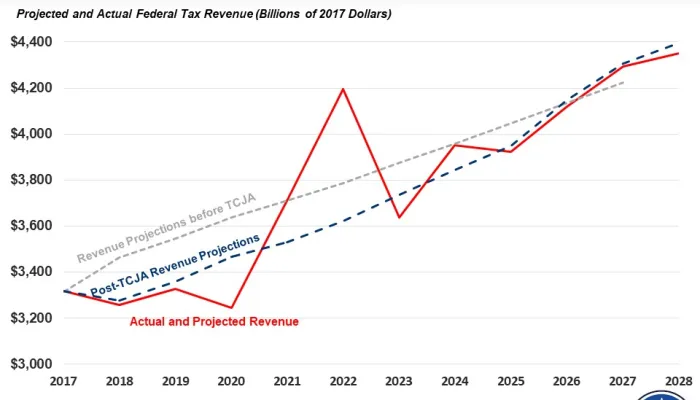Broadening Base-Broadening: "Beyond Tax Expenditures"
Readers of The Bottom Line know that we talk frequently on the subject of tax expenditures, the deductions, credits, and other tax preferences which cost us $1.3 trillion a year relative to what a clean tax code would look like. Reducing or reforming these preferences are vital to achieving tax reform, which is why we are enthused about the "blank slate" approach moving forward in the Senate Finance Committee.
However, not all deductions, credits, and related provisions are tax expenditures; some are structural parts of the tax code, including many that are used to help calculate net income. Although they are not deviations from a "clean" tax code, these provisions can be quite costly relative to a code that excluded them and are the topic of a new Tax Notes paper by CRFB's own Marc Goldwein, Adam Rosenberg, and Jessica Stone*.
In "Beyond Tax Expenditures," Goldwein, Rosenberg, and Stone discuss what they call Non-Tax-Expenditure Base Provisions (NTEBPs) and suggest that many of these NTEPs could and should be modified in the context of comprehensive tax reform. The paper argues that while it is technically possible to achieve sweeping tax reform that reduces tax expenditures and tax rates while raising revenue, political and administrative difficulties may make that task tough to meet without looking at another source of revenue such as NTEBPs. This should be no surprise, as the last sweeping tax reform in 1986 actually raised about 40 percent of its gross revenue from sources other than tax expenditures.
Most NTEBPs, the paper argues, are integral parts of the tax system that should not be modified or removed. However, a subset of them may be quite ripe for reform. The authors lay out five criteria for evaluating NTEBPs that could be reformed.
1. Improperly defined income. Some expenses may be immediately deductible as a normal expense when an argument can be made that they should either not count against income at all or not count against current-year income alone. Principles of taxation dictate that expenses used to produce income over several years should be deducted over that same period (the useful life of that expense). While the current code attempts to depreciate those income-generating assets when appropriate, there may be times when it fails in that goal.
2. Dual-purpose provisions. A pure income tax allows for the deduction of normal business expenses in order to calculate net income for the purpose of taxation. However, some expenses may simultaneously have a businesspurpose for generating income and an individual benefit promoting personal welfare. In that case, policymakers may want to consider modifications such as a partial deduction.
3. Abused provisions. Some NTEBPs may be justifiable adjustments to income in theory but in practice be heavily abused. This is especially true for dual-purpose provisions, where the line between personal and business expenses is blurred. To reduce the incentive for abuse, policymakers could tighten eligibility for, restructure, or eliminate some of these provisions.
4. Provisions in conflict with public policy goals. Some provisions in the code may actually work against important policy goals by encouraging undesirable behavior and creating undesired income distribution outcomes, in addition to lowering potential tax revenue. Policymakers could alter specific NTEBPs that they believe conflict with other public policy goals.
5. Tax expenditure proxy provisions. Some tax expenditures may be difficult to eliminate directly but possible to address indirectly. For example, some forms of compensation are both excludable for individuals and deductible for employers. Technically, the exclusion is the tax expenditure and the deduction is a normal feature of the tax code (as a normal business expense). However, it may prove politically or administratively difficult to address the exclusion or other tax expenditure itself, in which case the parallel NTEBP could be modified as a proxy. Although this article does not address tax expenditure proxy provisions, more research should be conducted in this area.
In addition to explaining how NTEBPs differ from tax expenditures and laying out a criteria for judging NTEBPs, the authors present a number of examples of specific NTEBPs that could be reformed based on the criteria. Examples of NTEBPs on the individual side include the standard deduction and personal exemptions, the deferral of taxes on capital gains until they are realized, and deductions for moving expenses. Examples on the business side include deductions for interest expenses, meals and enertainment expenses, and full expensing of advertising costs which may have benefits over a number of years. We've previously discussed a number of these provisions on our blog.
The list the authors put forward is far from exhaustive, but rather a starting point from which the academic and tax community can build.

Tax expenditures can and should be the focus of tax reform since there are serious revenue implications and plenty justification to eliminate or reduce many of the provisions that are there. However, policymakers should not ignore opportunities to improve the tax code through alternate forms of base-broadening. Reforming both tax expenditures and certain NTEBPs are complementary steps to make the tax system more efficient and raise revenue.
Click here to read the full paper.
*Note: Jessica Stone was a policy analyst at the time the analysis was written, but currently works in a congressional office.


